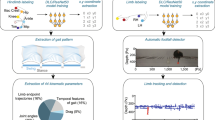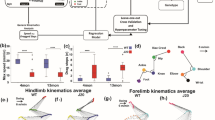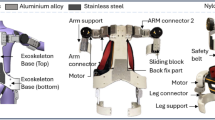Abstract
Study design:
To compare results obtained with a variety of locomotor rating scales in Th9/10 spinal cord transected (Tx) mice.
Objectives:
To assess spontaneous recovery with a variety of rating scales to find the most sensitive methods for assessing recovery levels in Tx mice and differences associated with gender and condition.
Setting:
Laval University Medical Center, Neuroscience Unit & Laval University, Department of Anatomy and Physiology, Quebec City, Quebec, Canada.
Methods:
Scales including the Basso, Beattie and Bresnahan (BBB), the Basso Mouse Score (BMS), the Antri, Orsal and Barthe (AOB), the Motor Function Score (MFS) and the Averaged Combined Score (ACOS) were used to assess, in open-field and treadmill conditions, spontaneous locomotor recovery in male and female Tx mice.
Results:
The ACOS scale revealed a progressive increase of spontaneous recovery during 5-weeks post-Tx. The other methods detected a progressive increase for the first 2–3 weeks post-Tx without any significant progress in weeks 4 and 5. Generally, scores obtained with each method were nonsignificantly different between males and females or between open-field and treadmill conditions.
Conclusion:
These results further confirm the existence of a limited but significant increase of locomotor function recovery, occurring without intervention, in Tx animals. Although each method could detect small levels of recovery, the ACOS method was discriminative enough to detect progressive changes up to 5 weeks post-Tx. In conclusion, the ACOS rating scale was the most discriminative method for assessing the spontaneous return of hindlimb movements found in Tx mice, both in open-field and treadmill conditions.
Similar content being viewed by others
Log in or create a free account to read this content
Gain free access to this article, as well as selected content from this journal and more on nature.com
or
References
Schwab ME . Repairing the injured spinal cord. Science 2002; 295: 1029–1031.
Steward O et al. Genetic approaches to neurotrauma research: opportunities and potential pitfalls of murine models. Exp Neurol 1999; 157: 19–42.
Kwon BK, Oxland TR, Tetzlaff W . Animal models used in spinal cord regeneration research. Spine 2002; 27: 1504–1510.
Basso DM, Beattie MS, Bresnahan JC . A sensitive and reliable locomotor rating scale for open field testing in rats. J Neurotrauma 1995; 12: 1–21.
Dergham P, Ellezam B, Essagian C, Avedissian H, Lubell WD, McKerracher L . Rho signaling pathway targeted to promote spinal cord repair. J Neurosci 2002; 22: 6570–6577.
Basso DM . Behavioral testing after spinal cord injury: congruities, complexities, and controversies. J Neurotrauma 2004; 21: 395–404.
Farooque M . Spinal cord compression injury in the mouse: presentation of a model including assessment of motor dysfunction. Acta Neuropathol (Berlin) 2000; 100: 13–22.
Engesser-Cesar C, Anderson AJ, Basso DM, Edgerton VR, Cotman CW . Voluntary wheel running improves recovery from a moderate spinal cord injury. J Neurotrauma 2005; 22: 157–171.
Guertin PA . Semiquantitative assessment of hindlimb movement recovery without intervention in adult paraplegic mice. Spinal Cord 2005; 43: 162–166.
Antri M, Orsal D, Barthe JY . Locomotor recovery in the chronic spinal rat: effects of long-term treatment with a 5-HT2 agonist. Eur J Neurosci 2002; 16: 467–476.
Wamil AW, Wamil BD, Hellerqvist CG . CM101-mediated recovery of walking ability in adult mice paralyzed by spinal cord injury. Proc Natl Acad Sci USA 1998; 95: 13188–13193.
Ma M, Basso DM, Walters P, Stokes BT, Jakeman LB . Behavioral and histological outcomes following graded spinal cord contusion injury in the C57Bl/6 mouse. Exp Neurol 2001; 169: 239–254.
Antri M, Barthe JY, Mouffle C, Orsal D . Long-lasting recovery of locomotor function in chronic spinal rat following chronic combined pharmacological stimulation of serotonergic receptors with 8-OHDPAT and quipazine. Neurosci Lett 2005; 384: 162–167.
de Leon RD, Hodgson JA, Roy RR, Edgerton VR . Locomotor capacity attributable to step training versus spontaneous recovery after spinalization in adult cats. J Neurophysiol 1998; 79: 1329–1340.
Leblond H, L'Esperance M, Orsal D, Rossignol S . Treadmill locomotion in the intact and spinal mouse. J Neurosci 2003; 23: 11411–11419.
Guertin PA . Role of NMDA receptor activation in serotonin agonist-induced air-stepping in paraplegic mice. Spinal Cord 2004a; 42: 185–190.
Landry ES, Guertin PA . Differential effects of 5-HT(1) and 5-HT(2) receptor agonists on hindlimb movements in paraplegic mice. Prog Neuropsychopharmacol Biol Psychiatry 2004; 28: 1053–1060.
Guertin PA, Steuer I . Ionotropic 5-HT3 receptor agonist-induced motor responses in the hindlimbs of paraplegic mice. J Neurophysiol 2005; 94: 3397–3405.
Guertin PA . Synergistic activation of the central pattern generator for locomotion by l-beta-3,4-dihydroxyphenylalanine and quipazine in adult paraplegic mice. Neurosci Lett 2004b; 358: 71–74.
Basso DM, Beattie MS, Bresnahan JC . Graded histological and locomotor outcomes after spinal cord contusion using the NYU weight-drop device versus transection. Exp Neurol 1996; 139: 244–256.
Strauss I, Lev-Tov A . Neural pathways between sacrocaudal afferents and lumbar pattern generators in neonatal rats. J Neurophysiol 2003; 89: 773–784.
Bonnot A, Morin D, Viala D . Genesis of spontaneous rhythmic motor patterns in the lumbosacral spinal cord of neonate mouse. Brain Res Dev Brain Res 1998; 108: 89–99.
Norreel JC, Pflieger JF, Pearlstein E, Simeoni-Alias J, Clarac F, Vinay L . Reversible disorganization of the locomotor pattern after neonatal spinal cord transection in the rat. J Neurosci 2003; 23: 1924–1932.
Landry ES, Guertin PA . Profile of immediate early gene expression in the lumbar spinal cord of paraplegic mice. Soc Neurosci Abstr 2005; 865.2.
Talmadge RJ, Roy RR, Edgerton VR . Alterations in the glycinergic neurotransmitter system are associated with stepping behavior in neonatal spinal cord transected rats. Soc Neurosci Abstr 1996; 380.
Giroux N, Rossignol S, Reader TA . Autoradiographic study of alpha1- and alpha2-noradrenergic and serotonin1A receptors in the spinal cord of normal and chronically transected cats. J Comp Neurol 1999; 406: 402–414.
Ung RV, Landry ES, Lapointe N, Rouillard C, Levesque D, Guertin P . Expression, activation, and function of 5-HT2A receptor in the lumbar spinal cord of adult paraplegic mice. Soc Neurosci Abstr 2005; 516.7.
Guertin P, Angel MJ, Perreault MC, McCrea DA . Ankle extensor group I afferents excite extensors throughout the hindlimb during fictive locomotion in the cat. J Physiol 1995; 487: 197–209.
Perreault MC, Angel MJ, Guertin P, McCrea DA . Effects of stimulation of hindlimb flexor group II afferents during fictive locomotion in the cat. J Physiol 1995; 487: 211–220.
Kunkel-Bagden E, Dai HN, Bregman BS . Methods to assess the development and recovery of locomotor function after spinal cord injury in rats. Exp Neurol 1993; 119: 153–164.
Metz GA, Merkler D, Dietz V, Schwab ME, Fouad K . Efficient testing of motor function in spinal cord injured rats. Brain Res 2000; 883: 165–177.
Author information
Authors and Affiliations
Rights and permissions
About this article
Cite this article
Ung, R., Lapointe, N., Tremblay, C. et al. Spontaneous recovery of hindlimb movement in completely spinal cord transected mice: a comparison of assessment methods and conditions. Spinal Cord 45, 367–379 (2007). https://doi.org/10.1038/sj.sc.3101970
Published:
Issue date:
DOI: https://doi.org/10.1038/sj.sc.3101970
Keywords
This article is cited by
-
Effect of Gender on Recovery After Spinal Cord Injury
Translational Stroke Research (2013)
-
Non-assisted treadmill training does not improve motor recovery and body composition in spinal cord-transected mice
Spinal Cord (2010)



